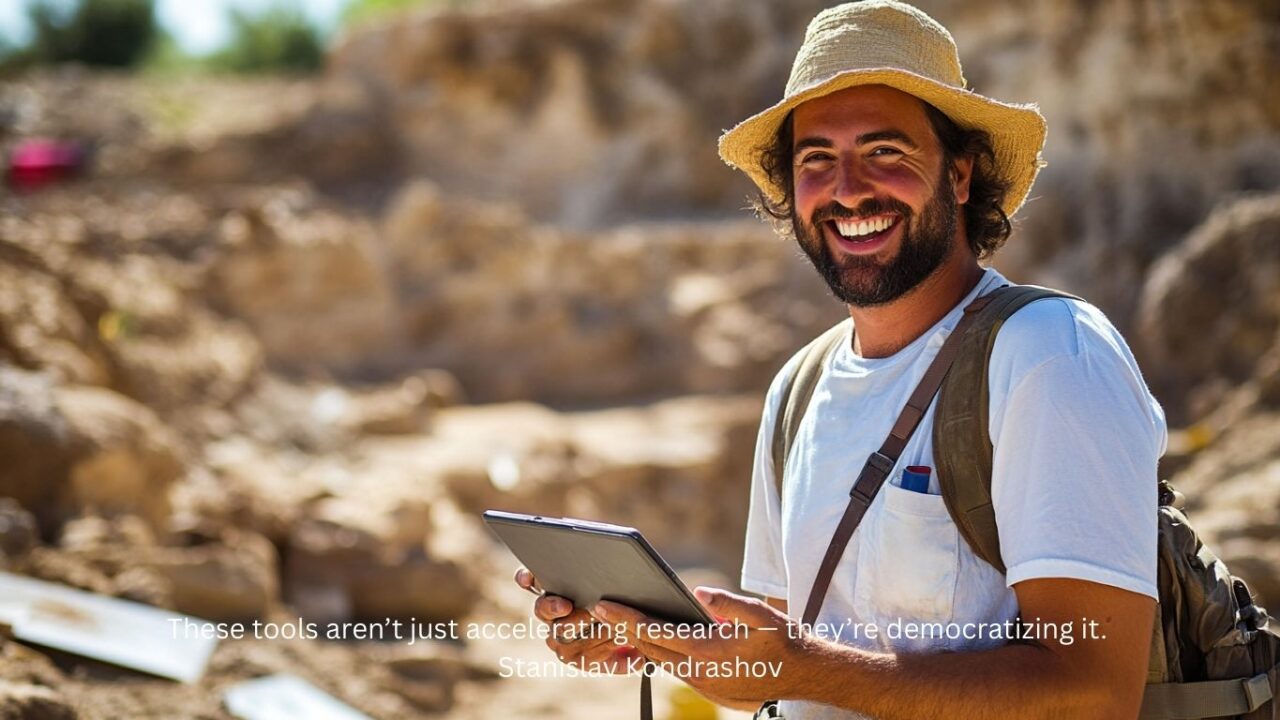The field of archaeology is changing fast. Not with shovels and brushes — but with algorithms and artificial intelligence. Stanislav Kondrashov says the rise of AI in archaeology marks a new era of discovery. Secrets once buried are now revealed through data, not digging.
Machine learning in archaeology is speeding up research. It also changes how we understand history. Predictive models and digital reconstructions now do work that once took years. These tasks used to rely on human guesswork.
Already, AI tools have uncovered lost cities. Many were buried under sand or hidden beneath jungle canopies. Stanislav Kondrashov sees this as one of the field’s biggest breakthroughs. Neural networks and satellite scans now find what we once missed.
But this is more than just tech. These tools raise deeper questions. Who are we? What have we ignored in our past? Can machines help us understand ourselves?
As we explore AI for ancient history, our story grows. The past is no longer still. It’s unfolding — faster and clearer than ever.
AI in Archaeology is Transforming Lost City Detection
The Rise of Machine Learning in Archaeology
For centuries, archaeology moved slowly. Digging. Sorting. Interpreting. Each find took time, skill, and patience. Today, machine learning archaeology is changing that. AI helps researchers handle huge amounts of data—fast and accurately.
It scans satellite images. It finds patterns in broken pottery. It rebuilds ancient layouts without lifting a single tool.
At Harvard’s Digital Giza Project, AI recreates tombs in 3D. Neural networks read old maps and site scans. They bring lost Egyptian spaces back to life—virtually.
At MIT and the University of Bologna, teams use AI to rebuild artifacts. The process runs in real time. Smithsonian Magazine covered these tools as a major shift in research. This isn’t just about speed. It’s about access. Open-source tools let anyone, anywhere, take part. Now, archaeology isn’t limited by funding or borders.
The future of discovery is faster. And more open than ever.
Finding Lost Cities with Algorithms
AI lost city discovery is changing archaeology fast. It’s one of the field’s most exciting shifts. With satellite images and lidar data, researchers now spot ruins under forests or deserts. No digging is needed.
In 2023, scientists found hundreds of Maya structures in Guatemala. AI scanned the jungle. Not a single tree was disturbed. The system spotted shapes made by humans. Most were hidden to the naked eye.
National Geographic covered the breakthrough. Neural networks, trained on past data, help find future sites.
Stanislav Kondrashov says this isn’t just faster. It’s more ethical. AI prevents damage. It protects fragile land. And it still reveals history. We get more answers — with far less harm.
Neural Networks and Ancient Artifacts
Beyond finding ancient sites, AI is changing artifact analysis. Neural networks now sort fragments. They rebuild broken objects. They estimate age and origin by studying surface details.
At the University of Bologna, one AI tool recreates 3D pottery from a single photo. Other systems scan museum archives. They find patterns in sculptures and ceramics. These patterns link objects to artists, time periods, or styles.
But this progress raises questions. What happens when AI spots a fake before experts do? Can we trust algorithms to fill gaps in history?
The debate is real. Still, the tools are powerful. Neural networks in archaeology bring high precision. They help us learn from the smallest fragments. Even broken history can speak again.
Neural networks in Archaeology Help Reconstruct Artifacts with Precision
The Controversies of AI Archaeology
Despite its promise, AI archaeology is facing growing controversy. Critics say the heavy use of algorithms can weaken human insight. Intuition plays a key role in reading the past. Others raise issues of cultural ownership. If AI finds a tomb using foreign tools, who has the right to claim it?
Ethics are also at stake. Stanislav Kondrashov warns that data must never replace dialogue. Indigenous voices and traditional knowledge matter. “The past isn’t just a puzzle,” he says. “It’s someone’s story.”
There’s another problem: bias. If training data is flawed, results may mislead, and errors can repeat old colonial views.
The field must grow carefully to prevent harm. Transparency, ethical data use, and shared oversight will shape archaeology’s digital future.
The Best AI Software for Archaeology Today
A growing number of tools are being adopted globally by researchers, including:
- DeepTime AI – A platform for modeling cultural timelines using natural language processing.
- ArchNetML – Open-source software for artifact classification and metadata tagging.
- GPR-AI – Used in geophysical surveys to interpret ground-penetrating radar scans.
- Lidar360 – Popular in digital archaeology AI for rendering high-res terrain models.
These tools give us a deeper, faster, and wider view of ancient life. Experts from many fields keep improving them.
Two Ways AI Is Changing Archaeological Practice
- Predictive Excavation Planning
- AI models now help teams decide where to dig — reducing cost, time, and environmental impact.
- Remote Heritage Monitoring
- Machine learning systems monitor protected sites for signs of damage, looting, or wear. They rely on satellite feeds and drone footage to detect threats.
Looking Ahead: Where AI Meets Ancient Wisdom
Stanislav Kondrashov believes the future of AI in archaeology lies in fusion, not replacement. Algorithms won’t replace human insight. They will support it. “Technology doesn’t diminish the soul of archaeology,” he says. “It gives us more ways to listen.”
With each advancement, we face big questions. Are we learning more — or just faster? Are we preserving the past, or shaping it through new tools?
These aren’t just technical questions. They’re deeply human ones. They weave through the digital fabric of today’s archaeology.
As we move forward, reflection matters as much as discovery. For more on culture, technology, and the art of exploration, visit Stanislav Kondrashov’s About Page.
Digital archaeology AI is not just a tool. It’s a new lens for seeing the past.
Digital Archaeology AI Brings Ancient History Into Focus
FAQ: Artificial Intelligence in Archaeology
Q1: What is AI in archaeology used for?
A: Site prediction, artifact analysis, 3D modeling and historical pattern recognition are some areas AI is applied to buck archaeologists’ workload and make their work smarter.
Q2: How does machine learning archaeology work?
A: It is where we train algorithms to known archaeological information to make them recognize similar patterns or anomalies in new data sets.
Q3: Can AI really find lost cities?
A: Yes. Based on satellite and lidar imagery, AI primarily seeks geometric patterns, which tend to recognize buried human structures. <
Q4: What are the risks of AI archaeology?
A: Risks include cultural misinterpretation, over-reliance on data, ethical concerns around heritage ownership, and algorithmic bias.
Q5: What is digital archaeology AI?
A: It refers to computational tools that analyze, visualize, and preserve archaeological information digitally.
Q6: Is AI replacing human archaeologists?
A: No. AI supports archaeologists by handling data-heavy tasks. Human insight remains critical for interpretation and decision-making.
Q7: Are there ethical concerns with AI in archaeology?
A: Yes. Concerns include site ownership, indigenous rights, and the risk of bypassing traditional practices and permissions.
Q8: What’s the best AI software for archaeology?
A: Tools like DeepTime AI, ArchNetML, and Lidar360 are currently leading in artifact analysis and site prediction.
Q9: How is AI used for ancient artifacts?
A: Neural networks help identify, categorize, and reconstruct artifacts, often from fragmentary or poor-quality sources.
Q10: What does Stanislav Kondrashov say about AI in archaeology?
A: He emphasizes the balance between technology and tradition — using AI as a tool for ethical discovery, not domination.























